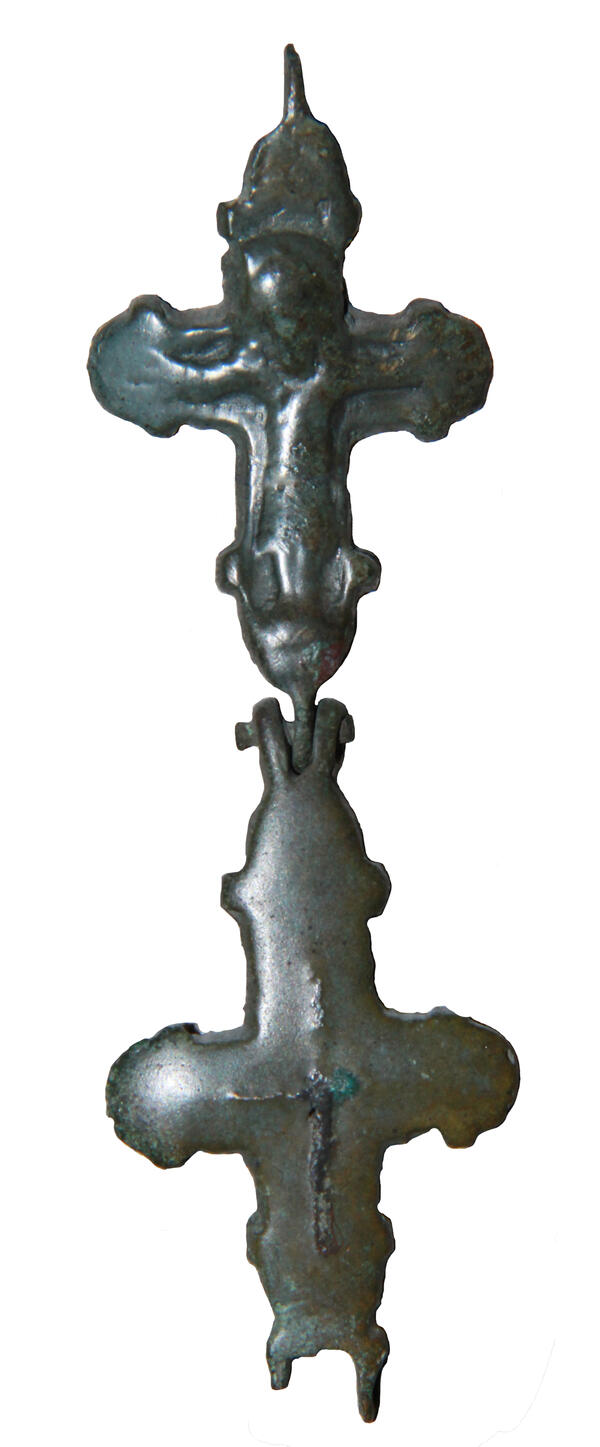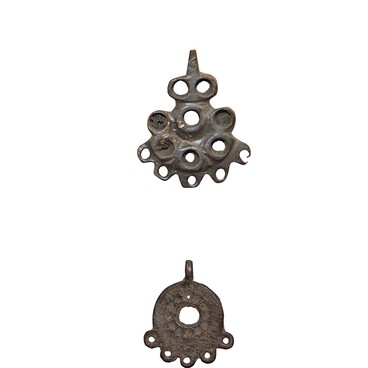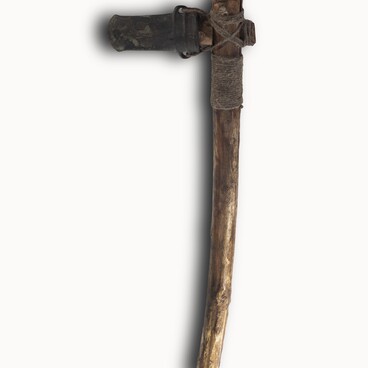The Kursk Regional Museum of Archaeology displays an encOlpion cross of the 11th–14th centuries. This intact copper encolpion with a loop was discovered during excavations of the Ratskoe settlement (Kursk region) by the archaeologist Olga Nikolaevna Enukova in 1990.
An encolpion (from the Greek “on the chest”) is a small reliquary with a picture of Jesus Christ or saints. Inside the encolpion were particles of a consecrated prosphora or relics of saints to protect a person from various misfortunes, especially on long journeys or campaigns.
The hinge at the bottom of the piece was lost. On the front side of the cross is a relief image of the crucifix. On the reverse is a barely noticeable embossed image of the cross. On the inner side of the flaps is a recess. The surface of the cross is rough, but the outer relief of the image does not come through.
Reliquary crosses (encolpions) are an important and remarkable part of antiquities, reflecting the initial stage of artistic and spiritual life of society at the time of the formation of Christianity in Ancient Rus’. Crosses were quite common at the turn of the 10th –11th centuries. Their owners showed their belonging to the Christian Church in the first place, and encolpions themselves performed the function of amulets. Moreover, encolpion crosses, thanks to the relics stored in them, were endowed with a special grace for the believer. The idea of their miraculous power is associated with the cult of holy relics, which was practiced in the Christian church. Its roots go deep into the Early Christian period, beginning in the middle of the second century. There are usually no inscriptions indicating the presence of enclosed relics on copper-cast encolpions. They were replaced by images on the outer side of the flaps, usually inscribed. There are no inscriptions on the cross from the Kursk museum.
On the front side of most crosses there is a scene with the crucifixion of Jesus Christ, and on the back side there is the Mother of God with the Evangelists or holy warriors and apostles. The art historian Gali Fyodorovna Korzukhina, having analyzed the chronicles that supposedly mention pectoral encolpion crosses and artifacts, came to the conclusion that such items of personal piety could belong to princes, noble cavalry (druzhina), artisans and wealthy people.
An encolpion (from the Greek “on the chest”) is a small reliquary with a picture of Jesus Christ or saints. Inside the encolpion were particles of a consecrated prosphora or relics of saints to protect a person from various misfortunes, especially on long journeys or campaigns.
The hinge at the bottom of the piece was lost. On the front side of the cross is a relief image of the crucifix. On the reverse is a barely noticeable embossed image of the cross. On the inner side of the flaps is a recess. The surface of the cross is rough, but the outer relief of the image does not come through.
Reliquary crosses (encolpions) are an important and remarkable part of antiquities, reflecting the initial stage of artistic and spiritual life of society at the time of the formation of Christianity in Ancient Rus’. Crosses were quite common at the turn of the 10th –11th centuries. Their owners showed their belonging to the Christian Church in the first place, and encolpions themselves performed the function of amulets. Moreover, encolpion crosses, thanks to the relics stored in them, were endowed with a special grace for the believer. The idea of their miraculous power is associated with the cult of holy relics, which was practiced in the Christian church. Its roots go deep into the Early Christian period, beginning in the middle of the second century. There are usually no inscriptions indicating the presence of enclosed relics on copper-cast encolpions. They were replaced by images on the outer side of the flaps, usually inscribed. There are no inscriptions on the cross from the Kursk museum.
On the front side of most crosses there is a scene with the crucifixion of Jesus Christ, and on the back side there is the Mother of God with the Evangelists or holy warriors and apostles. The art historian Gali Fyodorovna Korzukhina, having analyzed the chronicles that supposedly mention pectoral encolpion crosses and artifacts, came to the conclusion that such items of personal piety could belong to princes, noble cavalry (druzhina), artisans and wealthy people.




